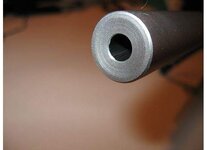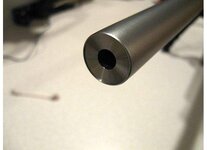- Messages
- 2,405
- Reactions
- 577
I have a factory rifle that shoots really nice but just can't get the last measure of accuracy out of it. On close inspection it has what is best described as a "Mass Produced Factory Crown Job" on the barrel. Someone gave it a quick swipe with the lathe bit, a bit of a counter-sink chamfer, and put it on the action. That's the only part of the rifle that was done cheaply. It's easy to tell that it's time to be re-crowned as even the "soot marks" on the muzzle are uneven.
I don't plan on pulling the barrel off and re-crowning it in a lathe but am going to pick up a 79 degree reamer with pilots and do the job by hand.
Question is, since the muzzle measures just over .800, and the max reamer dia is .750 can I continue the crown deeper and leave a protective rim around it similar to the military crown on the M-24 of should I just keep the outer edge flush with the rest of the muzzle?
What about "breaking" the edge of the crown where it joins the bore by lapping or should I just leave it as sharp as possible. The reamer I intend to use has many cutter faces and should be not only chatter free (when turned by hand) but also leave a knife edge at the bore. If the edge is clear of burrs and doesn't catch on a patch or q-tip is anything more really required. Opinions seem to vary so I'm looking for some here.
Lastly, has anyone else done this and kept a hand reamer for touching up the muzzle crown before a match?
I don't plan on pulling the barrel off and re-crowning it in a lathe but am going to pick up a 79 degree reamer with pilots and do the job by hand.
Question is, since the muzzle measures just over .800, and the max reamer dia is .750 can I continue the crown deeper and leave a protective rim around it similar to the military crown on the M-24 of should I just keep the outer edge flush with the rest of the muzzle?
What about "breaking" the edge of the crown where it joins the bore by lapping or should I just leave it as sharp as possible. The reamer I intend to use has many cutter faces and should be not only chatter free (when turned by hand) but also leave a knife edge at the bore. If the edge is clear of burrs and doesn't catch on a patch or q-tip is anything more really required. Opinions seem to vary so I'm looking for some here.
Lastly, has anyone else done this and kept a hand reamer for touching up the muzzle crown before a match?













